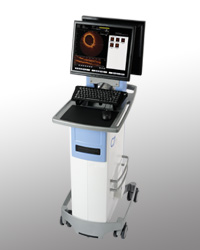New Technology at Long Beach Medical Center Helps Diagnosis Coronary Artery Disease Sooner
Coronary arteries are the blood vessels that supply blood, oxygen and nutrients to your heart muscle. The build-up of plague, cholesterol-containing deposits in your arteries, eventually leads to coronary artery disease (CAD). Plaque build-up may narrow and restrict your coronary arteries thus causing your heart muscle to receive less blood. This can be especially noticeable during physical activity, when your heart is beating more rapidly. At first, the restricted blood flow may not cause any symptoms. However, over time, as the plaque continues to accumulate and your arteries narrow, you may develop signs of coronary artery disease.
Leading Symptoms of Coronary Artery Disease:
- Chest pain (angina). You may feel pressure or tightness in your chest, as if someone were standing on your chest. The pain, referred to as angina, is usually triggered by physical or emotional stress. It typically goes away within minutes after stopping the stressful activity. In some people, especially women, this pain may be fleeting or sharp and noticed in the abdomen, back or arm.
- Shortness of breath. If your heart can't pump enough blood to meet your body's needs, you may develop shortness of breath or extreme fatigue with exertion.
- Heart attack. If a coronary artery becomes completely blocked, you may have a heart attack. The classic signs and symptoms of a heart attack include crushing pressure in your chest and pain in your shoulder or arm, sometimes with shortness of breath and sweating. Women are somewhat more likely than men are to experience less typical signs and symptoms of a heart attack, including nausea and back or jaw pain. Sometimes a heart attack occurs without any apparent signs or symptoms.
Because coronary artery disease often develops over decades, it can go virtually unnoticed until a complete blockage of the artery produces a heart attack. There's plenty you can do to prevent and treat coronary artery disease. Start by committing to a healthy lifestyle.
If you have risk factors for coronary artery disease — high blood pressure, high cholesterol, diabetes or obesity — talk to your doctor. You may need to be tested to determine if you have coronary artery disease, especially if you have experienced signs or symptoms of narrowed arteries. Even if there isn't a preliminary diagnosis, it is always best to reduce these risk factors to prevent coronary artery disease in the future. Early diagnosis and treatment may stop progression of coronary artery disease and help prevent a future heart attack.
Long Beach Medical Center Advances Care of Coronary Artery Disease With New Optical Coherence Tomography Platform

The MemorialCare Heart and Vascular Institute (MHVI) at Long Beach Medical Center has acquired the C7-XR™ OCT Intravascular Imaging System. The C7-XR System is a leading imaging technology platform that aids physicians in the diagnosis and treatment of cardiovascular disease. Using Optical Coherence Tomography (OCT), the C7-XR System utilizes near-infrared light to create images that go beyond older coronary imaging technologies - such as fluoroscopy and intravascular ultrasound (IVUS) - offering cardiologists an assessment method with enhanced clarity for their patients with coronary artery disease.